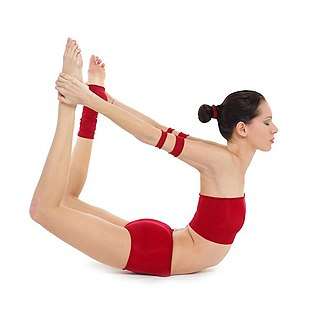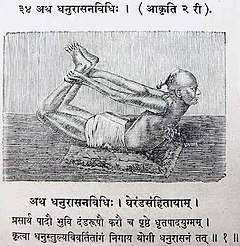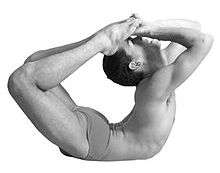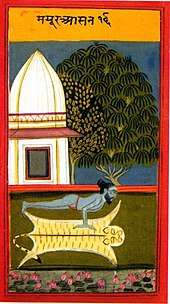Dhanurasana
Dhanurasana (Sanskrit: धनुरासन; IAST: Dhanurāsana), Bow pose,[1] [2] is a backbending asana in hatha yoga and modern yoga as exercise.

Etymology and origins

The name comes from the Sanskrit words धनुर (dhanur) meaning "bow",[4] and आसन (āsana) meaning "posture" or "seat".[5]
A similar pose named Nyubjasana, "the face-down asana", is described and illustrated in the 19th century Sritattvanidhi.[6] The pose is illustrated in half-tone in the 1905 Yogasopana Purvacatuska and named Dhanurāsana, quoting the Gheranda Samhita's description.[7]
It is unclear whether the asana is medieval, as although the name is used, the intended pose might be the sitting Akarna Dhanurasana rather than this backbend. The account of Dhanurasana in the 15th century Hatha Yoga Pradipika is ambiguous about whether the pose is reclining or sitting, stating[3]
Having held the big toes of both feet with both hands, one should pull [them] like a bow as far as the ears. This is called bow pose. (HYP 1.25)
The 17th century Gheranda Samhita is similarly ambiguous, stating
Spreading the legs on the ground, straight like a stick, and catching hold of the feet with the hands, and making the body bent like a bow, is called by the Yogis the Dhanurasana or Bow-posture. (GhS 2.18)[8]
Dhanurasana is used in the classical Indian dance form Bharatanatyam.[9]
Description
From a prone position, the feet are grasped to lift the legs and chest to form the shape of a bow with the body, the arms representing the bowstring.[10][11][12]
Variations

Variations include:
Follow-up asanas
Counter asanas are Halasana and Sarvangasana.[15]
See also
- Akarna Dhanurasana, a sitting pose resembling an archer shooting an arrow
- Salabhasana, an easier reclining backbend
- Urdhva Dhanurasana, the upwards bow or wheel
References
- "Bow Pose". Yoga Journal. Retrieved 2011-04-09.
- "Dhanurasana, Bow Pose". 5amyogi. Retrieved 2020-06-26.
- Hargreaves, Jacqueline; Birch, Jason (20 November 2017). "DHANURĀSANA: Two Versions of Bow Pose". The Luminescent.
- "Dhanurasana - AshtangaYoga.info". Archived from the original on 29 April 2011. Retrieved 11 April 2011.
- Sinha, S. C. (1 June 1996). Dictionary of Philosophy. Anmol Publications. p. 18. ISBN 978-81-7041-293-9.
- Sjoman 1999, pp. 84 and plate 19, pose 114.
- Ghamande, Yogi (1905). Yogasopana Purvacatuska. Bombay: Niranayasagar Press. p. 64, āsana 34.
- Vasu, Srisa Chandra (1979) [1914-1915]. The Gheranda Samhita (PDF). Delhi: Sri Satguru Publications. p. 15. Archived from the original (PDF) on 2014-01-24.
- Bhavanani, Ananda Balayogi; Bhavanani, Devasena (2001). "Bharatanatyam and Yoga". Archived from the original on 23 October 2006.
He also points out that these [Bharatanatyam dance] stances are very similar to Yoga Asanas, and in the Gopuram walls at Chidambaram, at least twenty different classical Yoga Asanas are depicted by the dancers, including Dhanurasana, Chakrasana, Vrikshasana, Natarajasana, Trivikramasana, Ananda Tandavasana, Padmasana, Siddhasana, Kaka Asana, Vrishchikasana and others.
- Iyengar 1979, pp. 101-102.
- Mehta 1990, p. 94.
- "Bow Pose - Dhanurasana". Yoga Journal. 28 August 2007. Retrieved 23 February 2019.
- Iyengar 1979, pp. 102-104.
- Vishnudevananda 1988, p. Plate 85.
- "Langkawi Yoga - Chakrasana (Wheel pose)". Retrieved 25 June 2011.
Counter pose: Halasana or Sarvangasana
Sources
- Iyengar, B. K. S. (1979) [1966]. Light on Yoga: Yoga Dipika. Thorsons. ISBN 978-1855381667.CS1 maint: ref=harv (link)
- Mehta, Silva; Mehta, Mira; Mehta, Shyam (1990). Yoga: The Iyengar Way. Dorling Kindersley. ISBN 978-0863184208.CS1 maint: ref=harv (link)
- Sjoman, Norman E. (1999) [1996]. The Yoga Tradition of the Mysore Palace (2nd ed.). Abhinav Publications. ISBN 81-7017-389-2.CS1 maint: ref=harv (link)
- Vishnudevananda, Swami (1988) [1960]. The Complete Illustrated Book of Yoga. Three Rivers Press. ISBN 0-517-88431-3.CS1 maint: ref=harv (link)
_from_Jogapradipika_1830_(detail).jpg)

